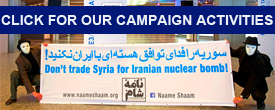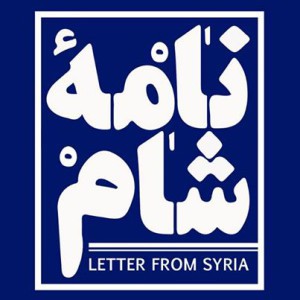 The Hague, 14 January 2015 – The campaign group Naame Shaam (1) today said that the destabilising policies of the Iranian regime in Iraq, Syria, Lebanon and Yemen are fueling religious extremism, which will inevitably lead to more terrorist attacks in the West like the recent one in Paris.
The Hague, 14 January 2015 – The campaign group Naame Shaam (1) today said that the destabilising policies of the Iranian regime in Iraq, Syria, Lebanon and Yemen are fueling religious extremism, which will inevitably lead to more terrorist attacks in the West like the recent one in Paris.
The Syrian regime would have collapsed a long time ago if it was not for the massive Iranian military and economic support. Sepah Pasdaran (Iran’s Revolutionary Guards) has sent thousands of Shia fighters from Hezbollah Lebanon, as well as Iraqi and Afghan ones, to help Bashar al-Assad’s regime fight rebels, killing hundreds of thousands of Sunni civilians and forcing millions to seek refuge in neighbouring countries.
In Iraq, since the US withdrawal in 2011, Sepah Pasdaran has helped the Shia-controlled government forces and militias oppress the Sunni minority. This, too, has been fueling sectarian tensions that have led to the rise of Daesh (or ISIS) and the latter’s ability to control large areas of Iraq and Syria.
“The Syrian and Iranian regimes have been trying to sell themselves as unavoidable partners in the international coalition against Daesh and other al-Qaeda-linked groups in the region,” said Shiar Youssef, Naame Shaam’s head of Advocacy and Research. “At the same time, both regimes have been facilitating and using these groups to their own advantage. Meanwhile, the foreign arm of Sepah Pasdaran, Sepah Qods, and the Shia militias it controls in Iraq and Syria continue to commit grave crimes against humanity and war crimes, which are exacerbating Sunni extremism in the region and beyond.”
A recent Naame Shaam report (2) documents the links between the Syrian and the Iranian regimes on the one hand and Daesh and other al-Qaeda-affiliated groups on the other. The report concludes that both the Syrian and the Iranian regimes have infiltrated, collaborated and used these terrorist groups to derail the Syrian revolution towards militarization and sectarianism and to justify their military actions against Syrian protesters and rebels.
Sepah Qods also played a key role in establishing, training and arming the Syrian regime’s militia known as the National Defence Forces (NDF) or the shabbiha. The NDF was modeled on the Iranian Basij force and its experience in suppressing Iran’s own dissident movements, particularly the 2009 pro-democracy protests known as the Green Movement. The Naame Shaam report includes many case studies of massacres committed by the NDF against Sunni civilians.
Naame Shaam’s Campaign Director Fouad Hamdan said: “Iran’s political and military leadership is complicit in mass murder in Iraq and Syria, and it is destabilising Lebanon via Hezbollah and Yemen via the Huthi militias. The Iranian regime is the root cause of wars and Sunni extremism in Iraq and Syria. The latest terrorist attacks in Paris are an indirect consequence of Sepah Qods helping kill and maim hundreds of thousands of Sunni Syrians and Iraqis and uprooting millions from their homes.”
“There would be no ISIS without the Assad regime and without the Iranian-backed Shia militias in Syria and Iraq,” Hamdan added. “The Iranian regime cannot just get away with mass murder and become a ‘partner’ in the international fight against terrorism.”
Meanwhile, the US administration has been pursuing a controversial strategy of letting the Iranian regime ‘slowly bleed’ in the war zones of Iraq and Syria, as well as in Lebanon and Yemen. It seems that US President Barack Obama and his team are still hoping that proxy wars with the Iranian regime in these countries, coupled with crippling economic sanctions against Iran and falling oil prices, would eventually lead to Tehran giving up its military nuclear plans, or even to the collapse of the Iranian regime (winning the Syria war in the streets of Tehran).
Naame Shaam has been demanding that Western negotiators in Vienna tell their Iranian counterparts that economic sanctions against Iran will not be lifted until the Iranian regime completely gives up its military nuclear programme, allows the formation of a truly inclusive government in Iraq, ends its military and financial support to the Syrian regime and pulls all its militias out of Syria. The Iranian regime must also end its support to the Huthi militias in Yemen and order Hezbollah Lebanon to disband its military wing. Only then a gradual lifting of economic sanctions against Iran should be considered.
Notes for editors:
1. Naame Shaam is a group of Iranian, Syrian and Lebanese activists and citizen-journalists that focuses on uncovering the role of the Iranian regime in Syria, www.naameshaam.org. Naame Shaam is run by the Netherlands-based Rule of Law Foundation, www.lawrules.org.
2. Naame Shaam published on 9 November 2014 an in-depth report on the role of the Iranian regime in the ongoing war in Syria. The key findings of the report, “Iran in Syria: From an Ally of the Regime to an Occupying Force”, include:
- The Iranian Revolutionary Guards are in control of all major military operations in regime-held areas in Syria. They control the Syrian military and other Syrian paramilitary forces such as the National Defense Forces known as the shabbiha. In May 2014, Sepah Pasdaran commander Brig. Gen. Hossein Hamedani said: “Bashar al-Assad is fighting this war [in Syria] as our deputy”. Regime-held areas in Syria are effectively occupied by Iran. The chief of Iran’s Sepah Qods force, General Qassem Soleimani, is the de facto ruler of Iranian-occupied Syria. Sepah Qods is the foreign arm of Sepah Pasdaran.
- The Iranian regime is complicit in war crimes and crimes against humanity committed in Syria. There is sufficient evidence to open investigations and bring law suits against the Iranian political and military leadership for its role in many of these crimes, including the Ghouta chemical attack in August 2013 and the use of barrel bombs against civilians.
- The primary objective behind Iran’s war in Syria is to keep arms shipments flowing to Hezbollah in Lebanon via Syria, so that this militia remains a strong deterrent against any possible attack against Iran’s military nuclear programme. The arms shipments are today totally dependent on vulnerable land routes passing through Syria.
3. Links related to the report “Iran in Syria: From an Ally of the Regime to an Occupying Force”:
- The full report is available in English
- The report’s Executive Summary is available in Arabic
- The report’s Executive Summary is available in Persian
- Press release about the launch of the report in English
- Press release about the launch of the report in Arabic
- Press release about the launch of the report in Persian
- New Narrative and Policy Recommendations in English
- New Narrative and Policy Recommendations in Arabic
 English
English  فارسی
فارسی  العربية
العربية 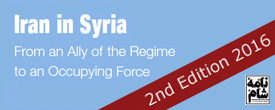
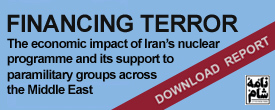
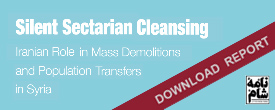
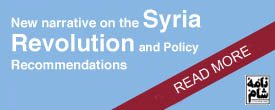

 On Twitter
On Twitter